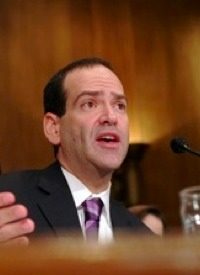
Special Inspector General of the Troubled Asset Relief Program (TARP) Neil Barofsky told House members on July 21 that the TARP program and other government bailout programs have mushroomed the liability of the federal government to $23.7 trillion.
In prepared testimony before the House Oversight and Government Reform Committee for July 21, Barofsky said: “Since the onset of the financial crisis in 2007, the Federal Government, through many agencies, has implemented dozens of programs that are broadly designed to support the economy and financial system. The total potential Federal Government support could reach up to $23.7 trillion.”
One indication of the immensity of Barofsky’s figure is that the entire U.S. Gross Domestic Product this year — the value of everything produced by every person in the United States — will only be $14.1 trillion, a little more than half of the bailout commitments made by the U.S. government over the past year. (Barofsky’s figure doesn’t count the nearly $3 trillion in other government spending as a regular part of the fiscal 2009 federal budget, of course.)
Treasury officials admitted Barofsky’s figure as accurate but claimed it was “inflated.” They stressed that Barofsky’s figures are worst-case scenarios that won’t pan out in reality. “The $23.7 trillion estimate generally includes programs at the hypothetical maximum size envisioned when they were established,” Treasury Department spokesman Andrew Williams told the press. “It was never likely that all these programs would be ‘maxed out’ at the same time.” Barofsky’s $23.7 trillion figure includes not only the TARP program, but also a dozen other bailout programs run by the U.S. Treasury Department, Federal Reserve Bank, veterans agency, and government-sponsored-enterprises such as Fannie Mae and Freddie Mac.
Barofsky also noted in his testimony that TARP funds were marked by rife waste and fraud, as well as from persistent Treasury Department resistance to openness about TARP expenditures to the public. On fraud, Barofsky testified that “SIGTARP[Office of the Special Inspector General for the Troubled Asset Relief Program] has 35 ongoing criminal and civil investigations. These investigations include complex issues concerning suspected accounting fraud, securities fraud, insider trading, mortgage servicer misconduct, mortgage fraud, public corruption, false statements, and tax investigations.”
The Obama administration may be able to deflect the political damage from allegations of fraud with TARP, in part because — although Obama voted in favor of the TARP legislation as a U.S. senator — corruption under the TARP program emerged immediately after Congress passed legislation in the fall of 2008. But Barofsky’s assertions of lack of transparency will definitely sting the Obama administration, since Obama campaigned and has continually promised more openness as president. Barofsky accuses the Treasury Department of ignoring four key recommendations regarding transparency:
Although SIGTARP understands Treasury’s need to balance the public’s transparency interests, on one hand, with the interests of the participants and the desire to have wide participation in the programs, on the other, Treasury’s default position should always be to require more disclosure rather than less and to provide the investors in TARP — the American taxpayers — as much information about what is being done with their money as possible. Unfortunately, in rejecting SIGTARP’s basic transparency recommendations, TARP has become a program in which taxpayers (i) are not being told what most of the TARP recipients are doing with their money, (ii) have still not been told how much their substantial investments are worth, and (iii) will not be told the full details of how their money is being invested. In SIGTARP’s view, the very credibility of TARP (and thus in large measure its chance of success) depends on whether Treasury will commit, indeed as in word, to operate TARP with the highest degree of transparency possible.
Williams called Barofsky’s figures “inflated,” and he’s probably right in that the worst-case scenario of $23.7 trillion in new debt will result from the current bailout commitments. Why wouldn’t he be right? After all, U.S. Treasury Department employees are the well-practiced experts on inflation.
But we don’t need anywhere near the worst-case scenario to prove that these bailouts were a bad idea. Treasury Department spokesman Andrew Williams stressed that the U.S. government had only spent about $2 trillion on bailouts so far. Of course, $2 trillion is the value of everything produced in the United States produced over the past seven weeks. Americans were sold on these bailouts on the basis that they would avoid a financial crisis. But what they will receive from the bailouts are nationwide family financial crises resulting from the debt, taxes, and inflation that these bailouts will mandate.
Photo of Neil Barofsky: AP Images



